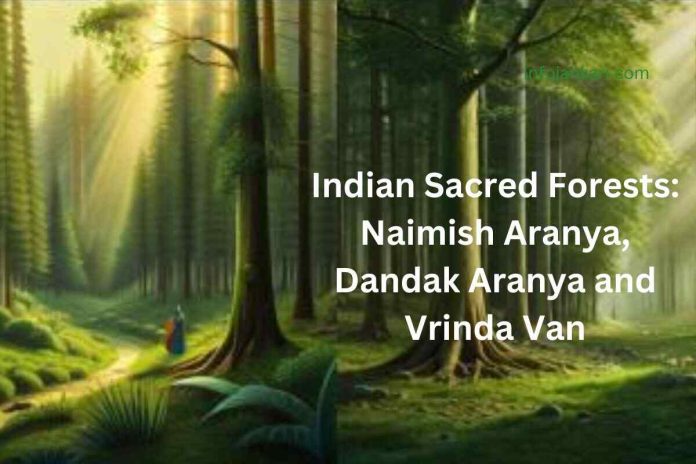Forests are the lungs of our planet, essential not just for local ecosystems but for the entire world. India, a land of diverse landscapes and ecosystems, boasts several famous sacred forests, each with its unique significance.
Sacred Forests: Naimish Aranya, Dandak Aranya, and Virnda Van
In this article, we delve into three remarkable Indian forests: Naimish Aranya, Dandak Aranya, and Vrinda Aranya, to understand how they contribute to the welfare of our world.
Naimish Aranya: The Sacred Grove of Knowledge
“Naimisharanya,” often referred to as Naimisha Forest or Naimisharanyam, is a sacred and historically significant pilgrimage site in India. This revered place is renowned for several reasons, including its deep-rooted history, spiritual significance, and association with ancient scriptures.
Historical Significance
Naimish Aranya, located in Uttar Pradesh, holds a revered place in Hindu mythology. It’s believed that sages performed an ancient sacrifice here, leading to its name ‘Naimish’ which means ‘to bow down.’ The forest is associated with profound spiritual and intellectual pursuits.
Contributions to the World
Naimish Aranya is not just a repository of ancient wisdom but also a sanctuary for diverse flora and fauna. Its lush green cover acts as a carbon sink, helping mitigate climate change. Moreover, the wisdom that emanated from this forest has enriched not only Indian culture but the entire world, making it a global treasure.
Dandak Aranya (Dandak Van): The Forest of Legends
Dandakaranya, a vast expanse of pristine wilderness, is a place where nature’s grandeur harmoniously intertwines with rich mythological tales. Located in central India, this region has captivated the hearts of travellers and pilgrims for centuries. Let’s embark on a journey to explore the fame, history, significance, and path to this captivating land.
Historical Significance
Dandak Aranya, situated in the Indian state of Chhattisgarh, is steeped in history and mythology. It’s famously known as the place where Lord Rama spent an initial 10 years out of fourteen years of his exile during the epic Ramayana. This forest is a testament to the endurance of nature.
Contributions to the World
While Dandak Aranya has historical and religious importance, it also plays a critical ecological role. Its vast expanse provides a habitat for various wildlife species, contributing to global biodiversity. Forests like these serve as crucial carbon reservoirs, benefiting the planet by helping regulate the climate.
Vrinda Van (Vrinda Aranya): The Divine Abode
Vrindavan, nestled in the heart of the sacred city of Vrindavan, stands as a testament to the profound love between Lord Krishna and Radha. This enchanting garden, known for its lush greenery, vibrant flowers, and divine ambience, holds a unique place in Hindu mythology and the hearts of devotees. Let’s uncover why Vrinda Van is famous, its historical significance, and how to experience its unparalleled charm.
Historical Significance
Vrinda Aranya, located in the sacred city of Vrindavan, is closely associated with the divine love between Lord Krishna and Radha. The word ‘Vrinda’ is derived from Radha’s name, emphasizing her central role in this enchanting love story.
Contributions to the World
Beyond its spiritual significance, Vrinda Aranya showcases the harmony between nature and divinity. This garden is not only a place of worship but also a sanctuary for various plant and bird species. In a world increasingly detached from nature, places like Vrinda Aranya remind us of the importance of preserving our natural heritage.
Conclusion:
These famous Indian forests—Naimish Aranya, Dandak Aranya, and Vrinda Aranya—are more than just geographical entities. They are repositories of history, spirituality, and ecological diversity. They serve as reminders of our interconnectedness with nature and the responsibility to protect these vital ecosystems. By doing so, we contribute not only to our local well-being but also to the welfare of the entire world.
Also Read: Unveiling the Science Behind Hindu Traditions: Exploring the Wisdom of Sanatan Dharma



